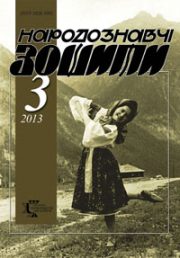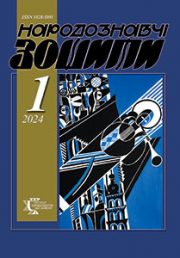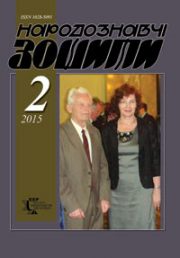The Ethnology Notebooks. 2022. № 5 (167), 1178—1184
UDK [7.04.03’06:27-526.62-312.47](477)
DOI https://doi.org/10.15407/nz2022.05.1178
VILNIUS ICON OF THE MOTHER OF GOD: GENESIS AND ATTRIBUTION OF SELECTED SAMPLES
SKOP Mykhailo
- ORCID ID: https://orcid.org/0000-0001-5901-8211
- postgraduate,
- Lviv National Academy of Arts,
- 38, Kubiiovycha Street, 79011, Lviv, Ukraine,
- Contacts: e-mail: neivanmade@gmail.com
Abstract. The article is devoted to the Vilnius Icon of the Mother of God and some copies.
The novelty of the topic lies in the synthesis of historical information and the results of art analysis of monuments to resolve a number of contradictions identified in previous studies. Differentiation of two iconographic types identified by researchers as Vil’na Icon of the Mother of God, attribution of known analogues and substantiation of versions about the appearance and disappearance of the icon.
The aim of the article is to investigate the artistic features and iconography of selected icons of Vil’na Icon of the Mother of God, to substantiate the version of the creation of one of the types of icons in the XVI century, and to prove that one of the known surviving copies lost in 1915.
The following methods were used for this purpose: formal-stylistic, comparative, method of iconographic analysis, method of reconstruction, analysis of historical data, method of studying the cultural context.
The object of research is selected samples of Vil’na Icon of the Mother of God. The subject of research is artistic features, attribution and iconography.
The study found that there is no reliable data on what Vil’na Icon of the Mother of God looked like before the 17th century; the hypothesis about the origin of both types of icons is substantiated.
There is evidence that the icon preserved in the collection of the Cathedral of the Virgin of Kazan in St. Petersburg may be a lost icon of Vilniaus Dievo Motinos.
Keywords: Theotokos Hodegetria, Theotokos of Vilnius, iconography, Leontiy Tarasevych, Zhovkva School of Icon Painting, Iconostasis, Ukrainian Icon Painting, Vilniaus Dievo Motinos, Miraculous Icon.
Received 29.09.2022
REFERENCES
- Homolicki, M. (1843). Dwa pomniki cerkwi Sw. Trojcy w Wilnie. Wizerunki i Roztrzaania Naukowe. Poczet Nowy drugi (Vol. 24, pp. 110—127) Wilno [in Polish].
- Riklius, T. Mislingas Vilniaus Mergeles Marijos atvaizdas (NZ-A vol. 2). Geg 9. Retrieved from: https://nzidinys.lt/tomas-riklius-mislingas-vilniaus-mergeles-marijos-atvaizdas-nz-a-nr-2/ (Last accessed: 21.12.2021) [in Lithuanian].
- Janoniene, R. (2017). Vilniaus Dievo Motinos ikona ir jos kultas Svc. Trejybes cerkveje. Menotyra, 1 (Vol. 24, pp. 1—16). Retrieved from:
- https://www.researchgate.net/publication/315989918 (Last accessed: 21.12.2021) [in Lithuanian].
- Stepovik, D. (1986). Leontiy Tarasevich and Ukrainian Baroque art. Kyiv: Naukova dumka [in Ukrainian].
- Skop, L. (2004). Painter of the icon of the Virgin Hodegetria from Mrazhnytsia. Lviv: Logos [in Ukrainian].
- Tomalska, J. (2012). Historia jednego zabytku. Ikona Matki Boskiej Bielskiej. Bialoruskie Zeszyty Historyczne (Vol. 36, pp. 23—40) [in Polish].
- Janocha, M. (2008). Ruskie i Rosyjskie Ikony Hodegetrii. Salvatoris Mater, 10/1, 153—172 [in Polish].
- Druzyuk, G., & Skop, M. (2022). Icon of Ivan Rutkovich «The Virgin of Odigitria» from the Kamianko-Buzka district: artistic features, attribution and iconography. Narodoznavchi zoshyty, 1, 36—49 [in Ukrainian].
- Shcherbitsky, I. (1885). Vilensky Holy Trinity Monastery. Vil’na: Tipografiya Gubernskogo pravleniya [in Russian].
- (1866). Collection of images of the revealed and miraculous icons of the Most Holy Theotokos in the Orthodox Church glorified. Moscow: Manukhin [in Russian].
- Piskun, J. (2010). Vilna Hodegetria Icon of the Mother of God. Retrieved from: https://www.pravenc.ru/text/158626.html (Last accessed: 21.12.2021) [in Russian].
- (2005). Grand Duchy of Lithuania. Encyclopedia (Vol. 1). Minsk: Belarusian Encyclopedia [in Belarusian].
- Volanas, A. (1583). Idololatriae loiolitarum Vilnensium oppugnatio (P. 13). Vilnae: Typis et sumptibus eiusdem Andreae Volani; per Joannem Kartzanum Velicensem [in Latin].
- Strukov, D. (2011). Album of drawings. 1864—1867. Minsk: Belaruskaya Entsyklapediya imya P. Brouki [in Belarussian].
- Image of the miraculous image of the Blessed Virgin of Vilnius. Fragment of an engraving. The second half of the XVIII century. From the meeting of A.V. Olsufyeva (From a series of 130 icons of the Blessed Virgin) Federal State Budgetary Institution «Russian National Library». Retrieved from: https://kp.rusneb.ru/item/material/5fcf8c5f991f3b91423467c3 (Last accessed: 21.12.2021) [in Russian].
- Klokova, G. (1991). Rosyjskie malarstwo ikonowe, Russian Icon Painting, Russische Ikonenmalerei (Pp. 184—185). Moskwa; Warszawa) [in Polish].
- Pelekh, M. (2012). Apostolic theme of the little-known iconostasis of the XVII century. Transfiguration Church in the village of Smolyn (Yavoriv region). Apologist (Vol. 32—33). Proceedings of the V International Conference in Lviv, November 23—24, 2012. «Christian sacred tradition: Faith, spirituality, art»; Theological collection of the Lviv Theological Academy of the UOC-KP (P. 108–111). Lviv [in Ukrainian].
- Orthodox Encyclopedia (Vol. 32). Retrieved from: https://www.pravenc.ru/text/1684331.html (Last accessed: 21.12. 2021) [in Russian].
- Image of the Kiev-Bratskaya icon #13772. Retrieved from: http://pravicon.com/image-13772 (Last accessed: 21.12.2021) [in Russian].






